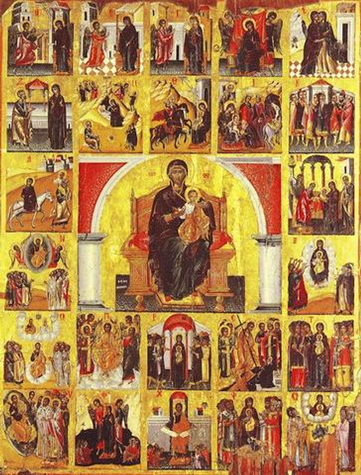AKATHIST

An Akathist Hymn (GR Akathistos "unseated hymn"; AR Madayeh) is a hymn dedicated to a saint, holy event, or one of the persons of the Holy Trinity. The name derives from the fact that normally all participants stand while it is being prayed. When the word akathist is used alone, it most commonly refers to the 6th century Akathist to the Theotokos, traditionally attributed to St. Romanos the Melodist. This hymn is sung on the first four Friday evenings in Great Lent; the entire Akathist is then sung on the fifth Friday evening. The Akathist Hymn begins with the Annunciation of the Virgin, and then refers to the events thereafter: The visitation of the Virgin to Elizabeth; the questions of Joseph the protector of the Virgin; the veneration of the Lord by the shepherds and magi; the fleeing of Christ to Egypt and the Presentation of Christ in the Temple. In the second half of the Hymn are words about the Incarnation of Christ, the Theosis of mankind and the worthiness of the Panagia (OrthoFlash Sept. 27, 2018) to be the Mother of God. The majority of the hymn is made up of praises directed to the Mother of God, always beginning with the salutation of the Archangel Gabriel: "Rejoice." The Church places the Salutations to the Theotokos during Great Lent because the Mother of God mediates on our behalf to God for the salvation of our souls. Within this Service, we supplicate our Mother to support us in our struggle during Great Lent; to intercede for us to God for the salvation of our souls and for a happy ending to this struggle, that it may be peaceful and sinless, so that with pure hearts we experience the Holy and Awesome passion of our Lord and then His Bright Resurrection.
ACATHISTE
L’ACATHISTE (GR akathistos « non assis »; AR Madayeh) est un hymne dédié à un saint, à un événement sacré ou à l’une des personnes de la Sainte Trinité. Lorsque le mot akathiste est utilisé seul, il fait généralement référence à l’Acathiste à la Mère de Dieu. Dans la tradition byzantine, les stances de cet Acathiste — le premier et le plus connu — sont distribuées sur les quatre premiers vendredis de Carême; l’hymne dans sa totalité est chanté le cinquième vendredi du Carême. Il semble que le texte soit lié historiquement au siège de Constantinople en 626, lorsque le patriarche Sergius organise la défense et consacre la ville à la mère de Dieu. Cet hymne, l’une des expressions les plus hautes et les plus célèbres de la piété mariale de la tradition orthodoxe byzantine, est chanté debout, par respect pour le mystère de l’Incarnation qu’il médite. L’Acathiste comporte vingt-quatre unités ou stances : elle débute par l’évocation de l’Annonciation par l’Archange Gabriel, la stupeur de la Toute sainte Mère de Dieu et son dialogue avec lui; elle annonce ensuite la conception par l’opération du Saint-Esprit, puis raconte la Visitation de la Vierge Marie à Élizabeth, les doutes de Joseph, l’adoration des bergers, la visite des Rois mages, l’offre de leurs dons à la Vierge Marie, la Fuite en Égypte, la Présentation au Temple. L’hymne s’achève par une louange au Verbe, Sauveur du monde, et une louange à Sa Mère, flambeau lumineux des hommes dans les ténèbres, temple de Dieu, protectrice de l’humanité en tout temps. L’Église place les salutations à la Mère de Dieu pendant le Grand carême, pour qu’elle nous soutienne dans notre lutte, qu’elle intercède pour nous auprès de Dieu pour le salut de notre âme, de sorte qu’avec le cœur pur nous fassions l’expérience de la passion de Notre Seigneur et de Sa résurrection.